Seeing tiny black bugs in the kitchen can be an unsettling sight. Moreover, their identification can also be difficult, as their species are varied. So, what are the tiny black bugs found in your kitchen?
The tiny black bugs found in your kitchen could be from the following species:
- Grain weevils — feed on cereal grains.
- Carpet Beetles — feed on fabrics and love to infest carpets.
- Drugstore Beetles — feed on a variety of foods from flour to bread and sweets to spices.
These insects are a great consumer of food products at home, as well as fabrics. Although they’re not known to cause sickness, their presence can be a nuisance and damage your food and fabric items.
Read on to learn more about these tiny black bugs, including their identification and natural methods to get rid of them.
Tiny Black Bugs in Kitchen | Identification
Seeing tiny black bugs in the kitchen isn’t a pretty sight. Apart from that, they can cause several damages, particularly to your fabrics and food items.
Grain Weevils
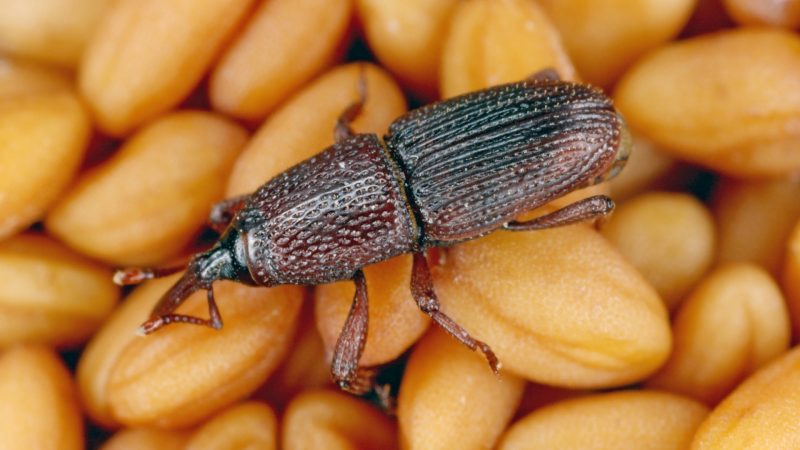
- Size: 2 to 3 mm long
- Shape: Cylindrical
- Antenna: Long elbowed antennae
- Threat: They can damage stored grains and other dry foods.
- Habitat: Grain storage and processing plants
- Location in the kitchen: Pantry
Grain weevils are among the most damaging pests of seeds and grain products. The adult grain or granary weevils are cylindrical and are approximately two to three millimeters long.
They have prolonged heads with a well-defined nose stretching downward from their head. These bugs have a glossy red-brown to a black color and possess rigid wing covers.
Furthermore, they have a trademarked thorax with oval cavities. The grain weevils can’t fly, opposed to maize and rice weevils.
Once the eggs are hatched, a fleshy, legless, soft, and white grub emerges and nibble on the cores of the grain kernel. This grub will then transform into a white cocoon and emerge later on as adult grain weevils.
Carpet Beetles
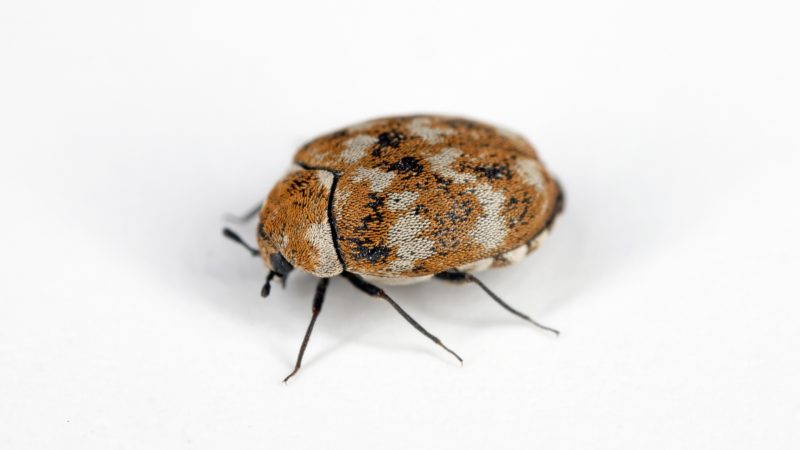
- Size: 3.18 mm to 8.1 mm long (adult black carpet beetles) 8 mm (full-sized larvae)
- Shape: Oval-shaped
- Antenna: Two antenna
- Threat: They love to nibble clothes, rugs, furniture and can also potentially cause an allergic reaction.
- Habitat: Edges of rugs and carpets (indoor); animal and bird nests or dens (outdoor)
- Location in the kitchen: Pantry, wall voids, crawlspace
Carpet beetles possess rounded, firm bodies and wings underneath their shells. These beetles have the same look as fuzzy worms with bands over their body. In addition, they have long hair-like extensions on each one or both ends of their bodies.
As the name suggests, carpet beetles infest carpets. They’re also highly damaging to other items, such as:
- Wool
- Fur
- Feathers
- Leather
Carpet beetles are attracted to materials containing keratin and fibrous animal protein. These types of materials can easily be digested and are preferred by larvae.
Furthermore, carpet beetles prefer dead insects, dander, dried meats, and peas. These bugs are hard to control as it’s difficult to locate the origin of their infestation.
Thus, the best way to contend with these beetles in your home is by reducing their food sources. Make sure to clean regularly to prevent accumulating hair, dander, and other food materials that carpet beetles love.
Cockroaches
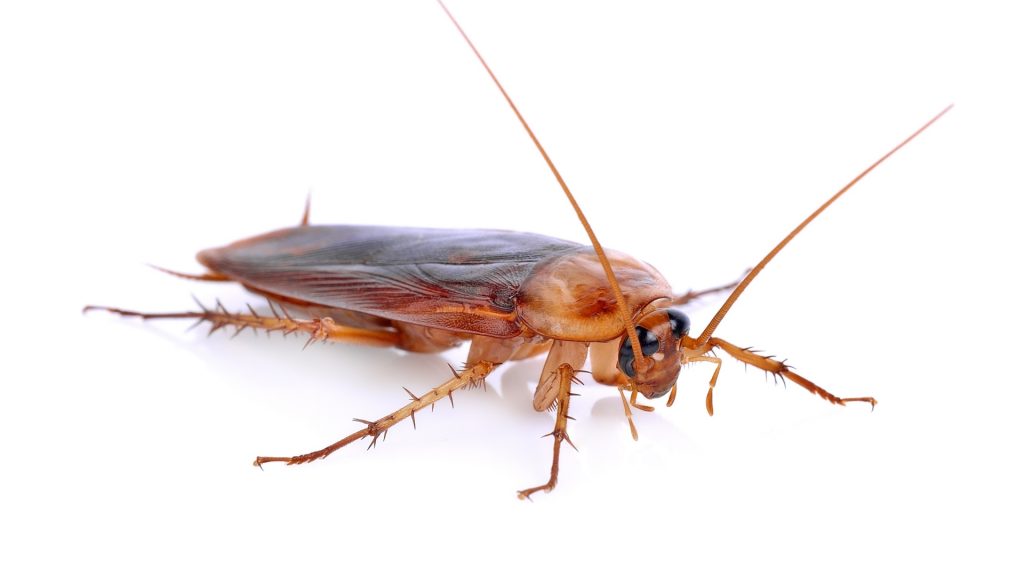
- Size: ½ of an inch to 2 inches long
- Shape: Flat, oval-shaped bodies
- Antenna: Filiform antennae
- Threat: They spread disease by contaminating human food with germs.
- Habitat: Dark, moist places. They’re often found behind refrigerators, sinks, as well as under floor drains. In addition, they also hide in cracks and crevices in walls.
- Location in the kitchen: Kitchen cupboards and countertops
Cockroaches are major pests, not just at home but also in restaurants, hospitals, warehouses, and other food-handling areas. Their excretion can stain surfaces and cause a foul odor.
Furthermore, they can also damage your paper products and fabric. In terms of characteristics, they have flattened oval bodies, long thread-like antennae, and glittering black or brown leathery integument.
Spider Beetle
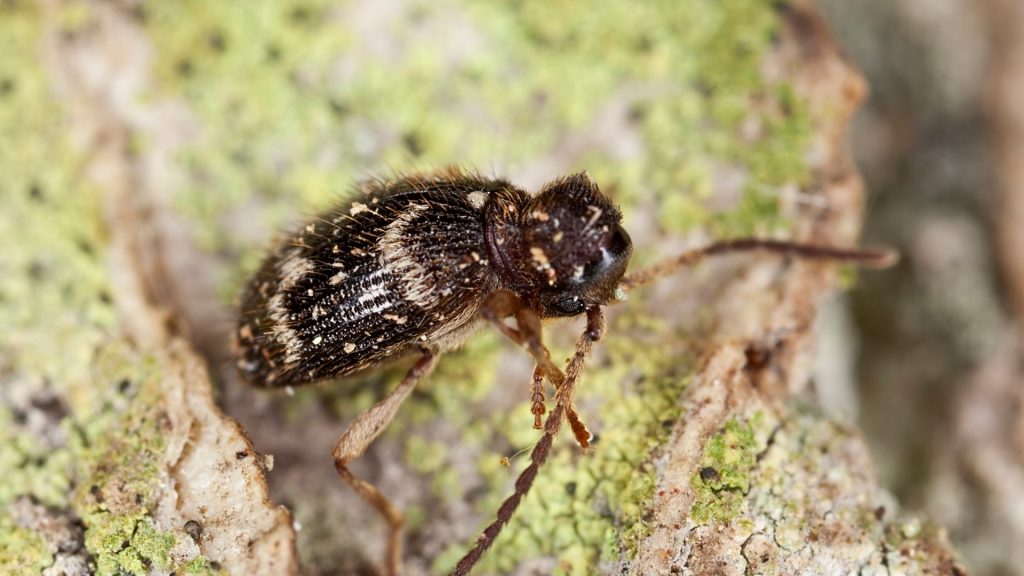
- Size: 1.5 to 3.5mm long
- Shape: Oval or cylindrical
- Antenna: A pair of two long antennae
- Threat: They are scavengers of stored food and may eat holes in packaging, leave webbing and pupae in food. Moreover, they can cause fabric damage.
- Habitat: Empty warehouses, mills, food processing facilities, and museums
- Location in the kitchen: Wall voids, drop ceiling, and pantry
Spider beetles are reddish-brown insects with six legs and a pair of long antennae. They have several colors ranging from reddish-brown to black and pale yellow to cream.
Furthermore, they prefer to feed on paper, pet food, stored seeds, animal droppings, dead insects, and woolens. These beetles deposit their eggs inside the piles of rodent or bird droppings.
When the eggs are hatched, the larvae start to feed and grow. The larvae then begin to spin silken webbing and silken cocoons to transform into adults.
Flour Beetle
- Size: 3.16 mm long
- Shape: Flattened, oval-shaped body
- Antenna: Club-like, three-segmented antennae
- Threat: Infest flour and cereals
- Habitat: Homes, grocery stores, malls, and food processing facilities
- Location in the kitchen: Pantry, cupboards
Flour beetles are shiny, reddish-brown insects that have flattened, oval-shaped bodies that have wings. They use their wings to fly short distances and possess distinctive antennae.
There are two kinds of flour beetles—the confused flour beetles and red flour beetles. These two are commonly known to attack stored grains and pantry foods.
They typically feed on finely ground or broken starch materials, such as flour. In addition, adults and larvae feed on fine-grind materials in warehouses, granaries, and kernels.
Cigarette Beetles
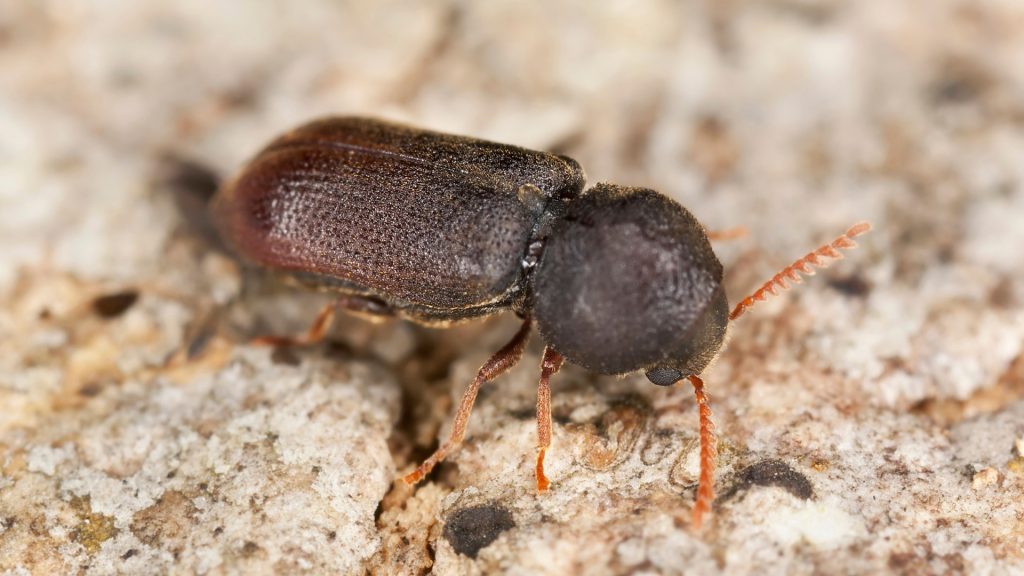
- Size: 2 to 3 mm long
- Shape: Oval
- Antenna: Serrated antennae
- Threat: They can damage items like books, book bindings, dry flowers, wreaths, and stuffed furniture
- Habitat: Cigarette beetles thrive in tropical and subtropical regions. They’re often found in areas where grains or other food is stored.
- Location in the kitchen: Cabinets, shelves, and pantries
Cigarette beetles are oval, yellowish-brown to reddish-brown insects that damage stored vegetables and tobacco materials. They have serrated antennae and possess strong wings, making them good fliers.
Their heads are bent downwards, giving their bodies a humpbacked look. The larvae are smaller than the adult, having a worm-like appearance and an off-white in color.
They consume various plant products as well as animal products. In addition, they also eat nuts, avocado, and unripe bananas.
Drugstore Beetles
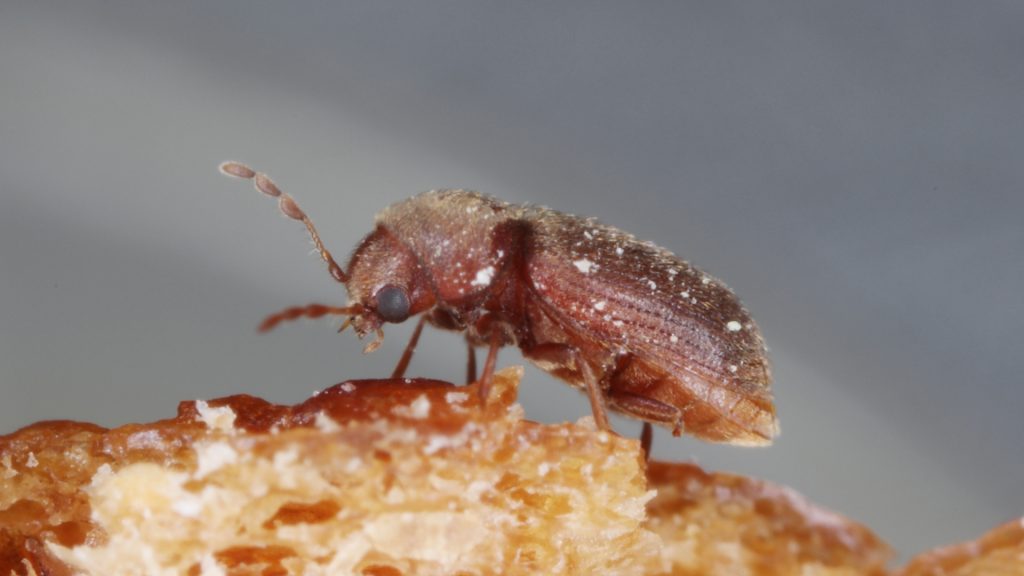
- Size: 2.54 mm long
- Shape: Elongated oval body shape
- Antenna: Serrated antennae
- Threat: Contamination and infestation
- Habitat: Drugstore, stored food items
- Location in the kitchen: Kitchen pantries, cabinets
Drug beetles are insects commonly known to infest tobacco products. They can be found infesting areas prone to spills and crumbs and live within stored foods and other items kept in unsecured containers.
These beetles are closely related to cigarette beetles and are small, having reddish-brown color. They love to infest the following:
- Grains
- Old rodent bait
- Red pepper
- Flour
- Spices
- Leather
- Animal hair
- Tobacco
- Pet food
- Tea
As their name suggests, they’re often found in drugstores, and are brought into the house through food items, and often spread to other products.
Indian Meal Moths
- Size: 19.05 mm
- Shape: Oval
- Antenna: Serrated antennae
- Threat: Infestation and spoiling foods
- Habitat: Stored food products, including grains, dried fruit, pet food, and spices.
- Location in the kitchen: Crawlspaces and cupboards
The Indian meal moths are one of the most troublesome pests of stored products. They love to consume dried milk, nuts, pet foods, whole grains, and dried fruits.
These pests can be introduced into your home through stored food products. Additionally, they pass through four stages during their life cycle: egg, larva, pupa, and adult. The female moth can lay up to 200 to 300 eggs in about a 1-18 day period directly onto food.
Natural Methods to Get Rid of Tiny Black Bugs
To get rid of tiny black bugs naturally, you may opt for the following ways:
Peppermint Oil
Peppermint oil is one of the best ways to manage tiny black bugs. This oil is also an effective repellent of ants, spiders, and mosquitoes.
To create a solution out of peppermint oil, mix 10 to 15 drops of this oil in an 8 oz of water inside a clean spray bottle. After that, shake and spray the mixture around vents, windows, and doorways.
Diatomaceous Earth (DE)
Another natural way to deal with tiny black bugs is by using Diatomaceous Earth or DE. This is made from crushed fossilized single-cell algae detrimental to insects, particularly to various types of bugs.
Just sprinkle DE to the affected areas and reapply if needed.
Neem Oil
Neem oil is effective in getting rid of tiny black bugs as they possess antimicrobial compounds. It can kill insects by suffocation, masking their bodies with oil that blocks their breathing openings.
Just spray the oil to the areas where you usually see bugs and wait for the result. Reapply as needed.
Related: Small Black Flies in Your Kitchen | How to Get Rid of Them
What to Spray on the Tiny Black Bugs in the Kitchen?
DIY Basil Spray
According to the Natural Society, basil can be a good insect repellent. To make a basil spray, you can follow these steps:
Step 1: Get six ounces of clean, fresh basil leaves. Put them in a container.
Step 2: Add four ounces of boiling water to the basil. Leave it for a few hours.
Step 3: Remove and squeeze all the moisture from the basil leaves.
Step 4: Once done, pour 4 ounces of apple cider vinegar into the basil and water mixture. If you’ve got a cheap vodka, you may use that instead of the cider vinegar.
Step 5: Pour the mixture into a spray bottle and spatter it on areas where these bugs are present.
Neem Oil Insecticide Spray
The compound causes insects to reduce or cease feeding can prevent larvae from maturing, reduces or interrupt mating behavior. In some cases, the oil coats the breathing holes of insects and kills them.
Neem oil insecticide spray is one of the best spray products that kills and repels various insect types, such as kitchen bugs. This insecticide spray can coat the breathing holes of insects, killing them effectively.
Summary
Tiny black bugs are pests that can damage your fabrics and spoil or contaminate your stored food. Thus, it’s essential to get rid of them right away before an infestation happens.
You may use natural methods, such as peppermint oil and Diatomaceous Earth (DE). In addition, you may also opt for neem oil insecticide spray or the DIY basil spray.
List of Sources
Russell, H. (2010). Carpet beetles. Michigan State University.
Jacobs, S. (2017). Spider Beetles. PennState Extension.
Merchant, M., Vinson, B. S., Brown, W. (2018). Flour Beetles. Texas A&M AgriLife Extension.
Drugstore Beetle, Stegobium paniceum. Oklahoma State University – Entomology & Plant Pathology.
- How to Get Rid of Copperheads | Practical Guide - August 27, 2023
- How to Get Rid of Corn Snakes | What Makes Them Aggressive? - August 27, 2023
- How to Get Rid of Alligators | Safety Measures and Removal Methods - July 16, 2023
